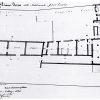Successor of an old aristocratic family, Teodoro Correr was born in Venice in 1750. Having been educated by the Theatine monks, he – without enthusiasm – began the usual career of a Venetian noblemen in public administration. However, he ultimately put an end to that by taking Holy Orders as an abbot in the Friars Minor.
After the fall of the Republic in 1797 and the institution of a provisional municipal government, he also managed to avoid service in the Guardia Civica. All of this was so that he could pursue his only true interest: collecting, a passion to which he was faithfully dedicated right up to his death in 1830. When he died, the “three salons and around twenty rooms” of his home contained – according to his will – “manuscripts, prints, pictures, books, works in copper, wood, silver and ivory, seals, minting dies, arms, classical antiques, coins, and objects of natural history, partially scattered around the place and partially organised”.
As a passionate collector, Correr was fortunate because in the last years of the Republic and the early years of the subsequent foreign rule over the city, an enormous quantity of antique objects, artworks, libraries, and whole collections were being sold off. Hence, there were remarkable opportunities for anyone trying to build up his own collection. Correr managed to put together an extraordinary amount of material, sometimes resorting to unscrupulous means or revealing a certain critical superficiality, often with a happy touch and a keen eye.
Driven by passion, and therefore far from following the rationally-meditated plan one would expect behind a modern museum collection, Teodoro Correr nevertheless considered the objects filling the rooms of his family palazzo at San Zan Degolà as forming a museum. Thus, he made it available to scholars and donated the collection to the city with the condition that it be organised and financed as a museum open to the public. His will laid down that “his home in San Jacopo dall’Orio at n. 1278, near San Giovanni Decollato, where the Museum is sited, should, from this point on, take the name Correr Collection; that it be open to the convenience of the public at least two days a week, from 9 in the morning to 3 in the afternoon, and that any scholar or art-lover may there […] see, transcribe and draw. What is more, three people are to be appointed, with adequate salaries, to the posts of curator, custodian and porter; and once the claims on the inheritance have been detracted, part of what is left shall be used to acquire objects to increase the museum collection. All property shall serve to run this public institution, which he places under the protection and tutelage of the City of Venice” (La Gazzetta di Venezia, 26 February 1830).



